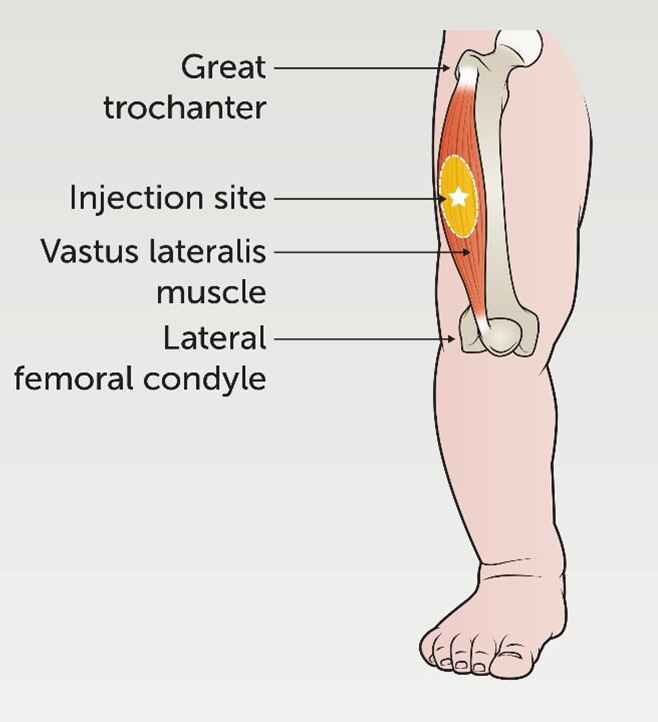A nurse is administering vitamin K injection to a newborn using the vastus lateralis muscle as the injection site.
Which of the following techniques should the nurse use to ensure proper needle placement?
Divide the thigh into thirds horizontally and vertically and use the outer middle third of the thigh.
Locate the greater trochanter and the lateral femoral condyle and use the middle third of this line.
Palpate the anterior iliac spine and the mid-patella and use the lateral aspect of this line
Identify the midpoint of a line drawn from the anterior superior iliac spine to the pubic tubercle and use this point
The Correct Answer is B
The correct answer is choice B. Locate the greater trochanter and the lateral femoral condyle and use the middle third of this line. This technique ensures proper needle placement in the vastus lateralis muscle, which is the preferred site for vitamin K injection in newborns. Vitamin K is given to prevent vitamin K deficiency bleeding (VKDB), which can cause serious bleeding problems in newborns.
Choice A is wrong because dividing the thigh into thirds horizontally and vertically and using the outer middle third of the thigh is a technique for locating the dorsogluteal site, which is not recommended for newborns.
Choice C is wrong because palpating the anterior iliac spine and the mid-patella and using the lateral aspect of this line is a technique for locating the rectus femoris site, which is an alternative site for vitamin K injection in newborns but not as preferred as the vastus lateralis site.
Choice D is wrong because identifying the midpoint of a line drawn from the anterior superior iliac spine to the pubic tubercle and using this point is a technique for locating the ventrogluteal site, which is not recommended for newborns.

Nursing Test Bank
Naxlex Comprehensive Predictor Exams
Related Questions
Correct Answer is C
Explanation
The correct answer is choice C. Check the medication label for the name, dose, expiry date and route of administration.
This is a standard precaution that should be taken before administering any medication to ensure patient safety and avoid medication errors.
Choice A is wrong because checking the newborn’s blood type and Rh factor is not necessary before giving vitamin K injection.
Vitamin K is not a blood product and does not depend on blood compatibility.
Choice B is wrong because checking the newborn’s bilirubin level and jaundice score is not relevant to vitamin K injection.Vitamin K is given to prevent vitamin K deficiency bleeding (VKDB), which is a serious condition that can cause bleeding in the brain or other organs.
Bilirubin level and jaundice score are indicators of neonatal jaundice, which is a common condition that causes yellowing of the skin and eyes due to excess bilirubin in the blood.
Choice D is wrong because checking the newborn’s weight and length measurements is not required before giving vitamin K injection.The recommended dose of vitamin K for newborns weighing more than 1500 g is 1 mg as a single intramuscular injection within 6 hours of birth.For preterm infants weighing less than 1500 g, the dose is 0.3 mg/kg to 0.5 mg/kg.
The dose does not depend on the exact weight or length of the newborn.
Correct Answer is A
Explanation
The correct answer is choice A.Petechiae, ecchymosis, or oozing from puncture sites are signs and symptoms of vitamin K deficiency bleeding (VKDB) in newborns.VKDB is a rare form of bleeding disorder that affects newborns and young infants due to low stores of vitamin K at birth.Vitamin K is a substance that our body needs to form clots and to stop bleeding.
Choice B is wrong because pallor, tachycardia, or poor perfusion are signs of anemia or shock, which can have many causes other than VKDB.
Choice C is wrong because jaundice, dark urine, or clay-colored stools are signs of liver disease or biliary obstruction, which can affect vitamin K absorption but are not specific for VKDB.
Choice D is wrong because hypoglycemia, lethargy, or jitteriness are signs of low blood sugar or neonatal abstinence syndrome, which are not related to VKDB.
Whether you are a student looking to ace your exams or a practicing nurse seeking to enhance your expertise , our nursing education contents will empower you with the confidence and competence to make a difference in the lives of patients and become a respected leader in the healthcare field.
Visit Naxlex, invest in your future and unlock endless possibilities with our unparalleled nursing education contents today
Report Wrong Answer on the Current Question
Do you disagree with the answer? If yes, what is your expected answer? Explain.
Kindly be descriptive with the issue you are facing.
